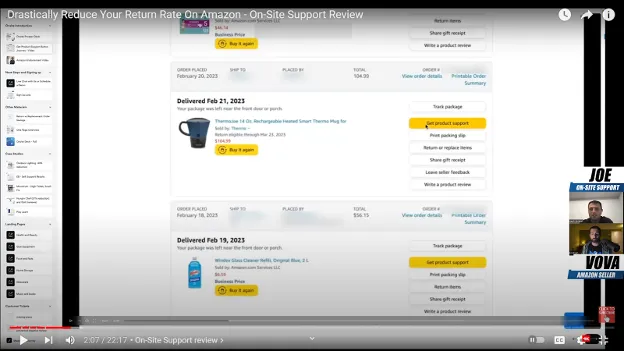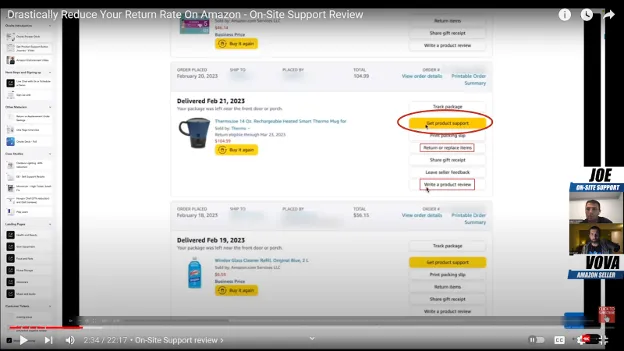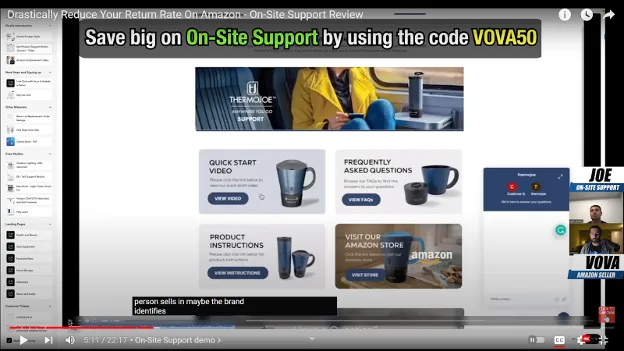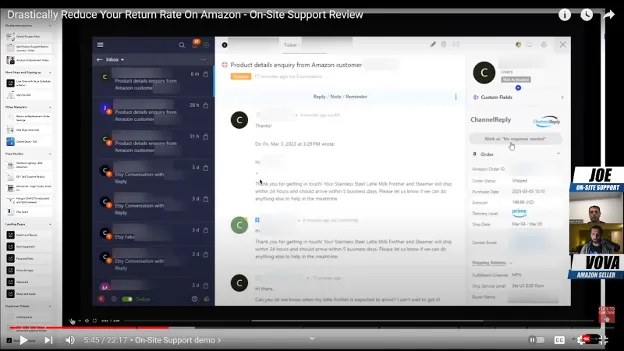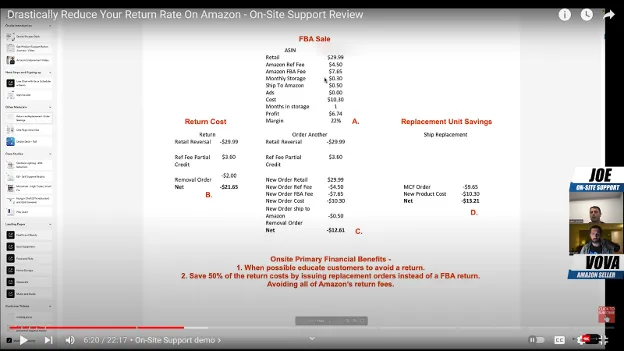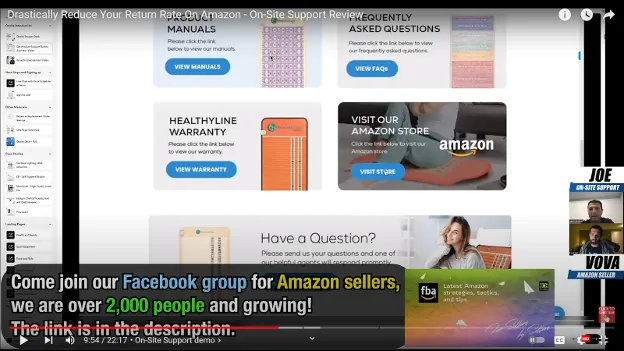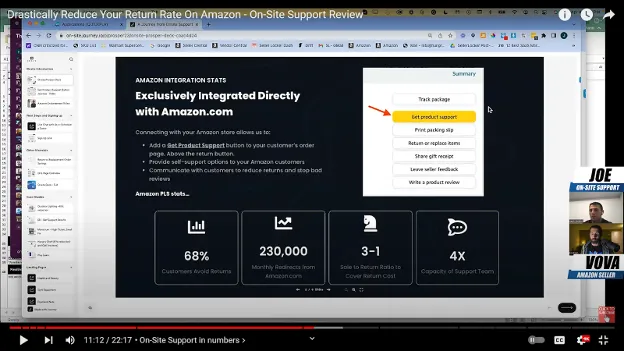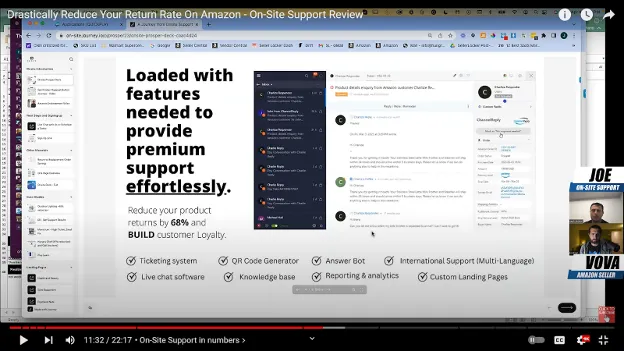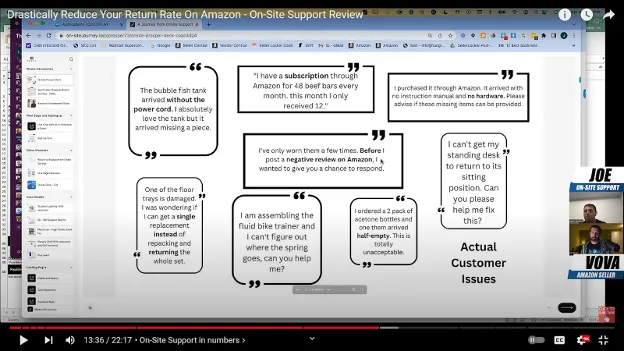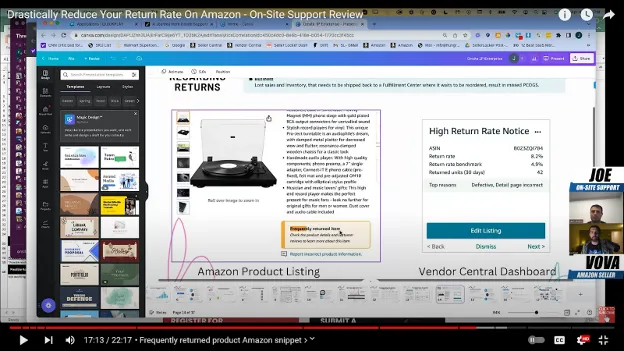Drastically Reduce Your Return Rate On Amazon - On-Site Support Review
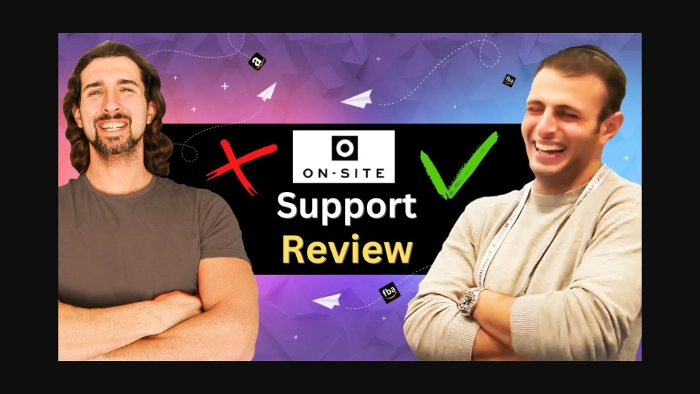
-
Boost Amazon FBA Sales with On-Site Support!
- Introduction
- Joe from On-Site Support
- What is On-Site Support and Why Joe Created It?
- On-Site Support Review
- On-Site Support Demo
- On-Site Support in Numbers
- On-Site Support Case Study
- "Frequently Returned Product" Snippet on Amazon
- On-Site Support Pricing
- On-Site Support Onboarding
- On-Site Support Discount
- The Bottom Line
Disclosure: Hi! It's Vova :) Some of the links in this article may be affiliate links. I get a commission if you purchase after clicking on the link, this does not cost you more money, and many times I can even get a nice discount for you. This helps me keep the content free forever. For you. Thank you! :)
Boost Amazon FBA Sales with On-Site Support!
Hey there!
Are you an Amazon FBA seller?
If you are, you know that one of the biggest headaches can be dealing with product returns.
But guess what?
I've got some fantastic news for you!
I am Vova Even, a Content Creator on YouTube and Udemy, and I recently chatted with Joe Abitbol, the co-founder of On-Site Support, a game-changing software made just for e-commerce folks like us. He also is the creator of Seller Locker, which is a tool for Amazon FBA reimbursements.
Coupon code VOVA50 will help you save 50% on the onboarding fees with On-Site Support.
And here’s the best part: It's all about helping YOU drastically cut down those pesky return rates.
But hold on, it gets even better!
Inside our conversation, there's a golden ticket - a discount code that'll save you a whopping 50% on the onboarding fees for On-Site Support.
Yes, you read that right – half off! 🎉
Now, why am I so excited about this?
Well, this isn't just any regular chat.
It’s a deep dive into the world of online selling and a treasure trove of insights.
And because I want everyone, no matter whether you are an expert or just started out, to get all the juicy details, I've kept our talk super simple and easy to read.
It's just like you're listening in on our actual conversation!
But hey, if reading isn't really your thing, no worries at all!
I've got a video of our chat right below.
So, you can watch and listen in.
Alright, it's time to dive deep!
Buckle up and let’s jump right into my enlightening conversation with Joe.
Trust me; you don't want to miss this! 😊🚀
___________________
Introduction
Vova: Hey everyone!
Welcome to today's post of On-Site Support review.
I bet you're wondering, "What's On-Site Support?"
Well, it's this cool software that can help you cut down those pesky return rates on Amazon, which means better customer experiences and a bigger, better bottom line for your business.
We'll be diving deep into how it all works, and I've even turned on the Table of Contents for you to hop around the article effortlessly.
But guess what?
I'm not alone.
Today, I've got Joe with me! Remember him?
Joe, the co-founder of On-Site Support, was previously with us on a video with Sarah Walker.
We chatted about Seller Locker.
(And hey, you can catch that video in the description as well!)
Plus, we've got a link to On-Site Support down below and any cool offers, you know I got you covered.
Joe from On-Site Support
Vova: Joe! Man, it does feel like ages since we last chatted, doesn't it?
How have you been?
Joe: Absolutely, Vova! Time flies, right?
Life's been treating me well, hope it's the same for you.
Vova: It sure does! All good at my end as well.
What is On-Site Support and Why Joe Created It?
Vova: Joe, I see that you're always cooking up solutions.
And this time, you're back again with another innovative solution, huh?
What's the scoop on this one?
Joe: You know us, Vova. We're problem solvers.
This time, we looked into two major issues e-commerce faces.
First, profit recovery, which is about plugging those leaks in business cash flows.
Then, tackling Amazon's mishaps with reimbursements.
But with the new tool called On-Site Support, we're focusing on another huge pain point – the costs from FBA returns.
Vova: Well, I must say that you guys really have a knack for addressing common business pain points.
Joe: Thank you, Vova! :)
You know, returns can be a huge drag on any e-commerce business.
And let me tell you, with Amazon FBA, those costs can skyrocket because of all the extra fees.
But with On-Site Support, we've developed a fantastic new solution.
This aims to not just cut down the frequency of those returns but, where we can, to chop those return costs in half.
On top of that, our goal is to prevent negative reviews that could be sidestepped with effective customer support.
Sounds exciting, right?
On-Site Support Review
Vova: Oh man, tell me about it!
As a seller, dealing with returns can be really challenging.
I mean, we strive to prevent them, but they do sneak in, and it affects the profits big time.
So, Joe, I'm eager to see what magic trick you've got up your sleeve with this!
Joe: Well, no time like the present, right?
Let's jump straight in.
If I could just share my screen, I'll walk you through the magic.
About 18 months ago, something interesting happened.
Amazon pitched an idea to me while I was managing a major company named Equity Brands as the director of e-commerce.
Being one of Amazon's top three vendors, they proposed a support mechanism for our products.
The idea?
They'd charge us around one or two dollars per ticket to add a support button on Amazon's "Orders" page.
So, when a customer goes to return or review a product, Amazon's own team would step in to troubleshoot.
Vova: Wait, so Amazon's team would provide support for things like microwaves and air conditioners?
Joe: Exactly, Vova.
And I was just as baffled!
How would Amazon's reps, with no specialized knowledge, support and fix specific products like air conditioners?
It didn't make any sense to us at the time.
It felt... out of place.
But given our software background, especially with experiences from Seller Locker and knowing firsthand the issues Amazon Sellers face, a thought popped up.
What if, instead of Amazon's reps, the brands themselves had a say in this?
If they could handle the support?
Imagine if the support button redirected to the brand's own trained personnel.
Vova: So, you mean having the brand's representatives handle the queries directly?
Interesting idea, Joe.
Joe: Exactly! We decided to give it a whirl internally.
The outcome?
Staggering.
But we realized to maintain this high-quality support, we needed specialized software.
Most tools available weren't tailored to e-commerce's unique demands.
For instance, integration with the API, designing effective landing pages to guide customers, accommodating multiple products or brand categories…
The list goes on.
Vova: Sounds like a lot to juggle.
I mean, e-commerce sellers already have a jam-packed schedule.
And setting up individual support landing pages for every product or category?
Phew!
Joe: Oh, it gets better.
We wondered, "What about QR codes? Can we bring them into the mix?"
Our ambition grew, and Amazon was all in.
With each new pilot tester we introduced, the positive outcomes just multiplied.
18 months later, here we are with hundreds of brands on board!
Plus, we're offering them a suite of tools.
We've got a team of skilled website designers, a crew for seamless integration, all ensuring sellers get the top-tier support system they deserve.
Vova: That's an epic journey in just 18 months, Joe!
On-Site Support Demo
Vova: I'm eager to dive deeper. Shall we?
Joe: Absolutely, Vova.
So, imagine this scenario: A customer heads to their Amazon orders page.
Rather than the usual "Return" or "Write a Product Review" options, there's this bright yellow button saying "Get Product Support."
It's pretty hard to miss.
Vova: I can see how that stands out!
And when they click on it?
Joe: They're taken to a dedicated support landing page tailored for the specific product they purchased.
These pages are designed to help the customer navigate any issues they might be facing.
From installation guidance, building instructions, to even product-specific care like washing tips.
The idea is to preemptively address common queries or challenges that customers may have.
Vova: So, for instance, if I bought a set of cups and one arrived damaged, the support page would guide me on what to do next?
Joe: Exactly. If a brand notices frequent issues with parts or components of a product, like your example of the damaged cup in a set, the support site would provide solutions.
We've designed these sites to anticipate the customer's problems.
Before setting them up, we even perform a detailed return audit to identify the primary reasons for returns and then ensure the support site addresses those concerns.
Vova: So, it's a blend of self-help and direct support?
Joe: Spot on, Vova. Ideally, the customer should be able to find the solution themselves from the landing page.
But if they can't, they can either use the live chat feature or "Submit a Ticket."
And just to clarify, brands don't need a full-blown live chat system; even a simple Contact Us form works.
When they submit a ticket, we instantly pull up all their order details from the API, like order date, product details, and return window status.
The ultimate aim?
Help the customer keep the product or get them a replacement, ensuring satisfaction.
Because here's the thing, Vova, the financial impact of an FBA return is monumental.
Let's break it down.
Imagine someone sells a $30 product on Amazon.
After accounting for the referral fee, Pick and Pack fee, the actual cost of the product, advertising, shipping it to Amazon, and storage fees, they'd be fortunate to pocket maybe five to six bucks on that thirty-dollar sale.
Vova: That's a slim profit margin.
Joe: Exactly. Now, consider a return. Amazon pulls the full $30 from the seller's account.
That tiny profit?
Gone.
And here's a shocker many brands aren't aware of: Amazon doesn't refund the Pick and Pack fee.
So sellers essentially cover the shipping cost.
And, to add insult to injury, there's often a return processing fee on that same $30 item.
Vova: So, for a product where they might've earned $5 or $6, a single return could mean a loss of...?
Joe: A whopping $21!
One return sets a seller back considerably.
They'd need three new orders just to recover from that single return.
It's potentially the most significant drain on your Amazon financial statement.
Many sellers have felt powerless because there wasn't a tangible way to mitigate this before.
Vova: That's a bitter pill to swallow.
But now, with the "Get Product Support" button…
The game would be different.
Joe: Exactly, Vova. One of our primary financial objectives with this program is to divert those returns and transform them into replacements.
It's a win-win for both the brand and the customer.
If you truly analyze the situation, Vova, customers clicking on "Get Product Support" generally want to keep the product.
If they intended to just return it, they would've clicked "Return," right?
Vova: Absolutely! It shows they're seeking a solution rather than simply giving up on the product.
Joe: Exactly. Now, if we can steer these customers towards a "Replace" option – be it through a chat or a dedicated section on the landing page suggesting a replacement – even if it means sending them a free unit while letting them retain the original, the costs plummet dramatically.
Vova: So, rather than that steep $21 or $24 loss, you're implying it can be reduced significantly?
Joe: Precisely! We might be looking at a reduced loss of around $13.
And for items with low production costs, it's conceivable to still see profit, even after dispatching a replacement.
The magic here, Vova, is the newfound opportunity for direct engagement with the customer, thanks to that yellow "Get Product Support" button.
Vova: It takes them straight to these specialized landing pages, doesn't it?
Joe: Right on. Instead of the "Return" button, they're now prompted to "Get Product Support," leading them directly to help from the brand itself.
We often try to anticipate common issues customers face and tailor the landing page accordingly.
So, it's not about making random guesses but rather providing targeted solutions based on their feedback: "Facing this issue? Click here" and so forth.
We'll sort out the specifics during our design sessions, where we understand the unique return reasons for each brand and design the page to best address them.
Vova: Alright, let me see if I've got this straight, Joe.
If people don't have any existing setup in place – for instance, they haven't integrated anything – does the "Get Product Support" button still show up for every seller?
Or is there a process to enable this feature?
And in scenarios where a seller doesn't have a designated support site, where do these customers end up?
Joe: Excellent questions, Vova.
So, the "Get Product Support" button isn't something that just appears for sellers by default.
Brands need to be enrolled in our program to have this feature.
Through our partnership with Amazon, we ensure that your brand is incorporated into the system.
Amazon needs to vet and approve the destination link we set up, ensuring it is strictly for support and not used as a sales or promotional platform.
It's paramount that it aligns with Amazon's policies.
Vova: So, you're saying you'll handle the entire landing page creation and hosting for the brands?
Joe: Precisely. We take the responsibility of crafting, hosting, and integrating the page with the necessary software.
While the page can have elements like Warranty Information, Troubleshooting Guides, and even a direct link back to your Amazon store, it has to be strictly within Amazon's Terms of Service.
You can have a button that says something like "Click to Leave an Honest Review."
Just remember that it has to be built within Amazon's Terms of Service.
That means no landing page should redirect users to any of the brand's standalone websites.
On our part, we do the enrollment, and build the landing page and your knowledge base.
Vova: Got it. And when you talk about building a knowledge base, are you suggesting creating instructional content like how-to guides and videos?
Joe: Yes, that's right! We work hand-in-hand with brands to develop a comprehensive knowledge base, utilizing the assets they provide.
This could include instructional content on product installation, use cases, and other relevant how-to videos.
What's more, this support can be multilingual, catering to both UK and US customers, among others.
Vova: So the ultimate goal here is not just to prevent returns or negative reviews but to establish a trustful relationship with the customer, right?
Joe: Exactly! It's about turning what could have been a negative experience into an opportunity, fostering trust and loyalty.
This way, customers are more likely to return for more purchases in the future.
Vova: That's some remarkable data, Joe.
So you're saying that by directing these customers to the landing page, brands are significantly reducing their return costs, and in some cases, even preventing returns altogether?
On-Site Support in Numbers
Joe: Exactly, Vova. From our observations last month, a whopping 230,000 customers clicked on the "Get Product Support" button.
The most impressive part is that, according to Amazon's own metrics, 68% of these users didn’t come back to process a return.
This essentially means the brands are resolving customer issues outside the Amazon platform, resulting in a drastic cut in associated costs by nearly half or even more.
Vova: Can you delve a bit deeper into these numbers?
Specifically, how is this system impacting different product categories?
Joe: Of course. This tool is proving beneficial across a broad range of categories.
Let's consider the apparel category as an example.
If a customer complains that an item shrunk after the first wash, it makes no business sense for the brand to ask the customer to return it to Amazon.
Why?
Because the product will most likely end up in Amazon's unsellable inventory, further increasing losses for the seller.
A more strategic approach would be to advise the customer to keep the product, or perhaps even replace it.
Vova: So, it's about being more proactive and understanding the cost implications of each return, right?
Joe: Precisely. By crunching the numbers, we've identified that a staggering 42% of returned products to Amazon are rendered unsellable.
So, if a brand gets, let's say, 100 returns in a month, 42 of those products are essentially write-offs.
It's crucial for brands to comprehend the economics of this.
If you weigh the costs of products being shipped back to Amazon and them ending up unsellable versus offering free returns or replacements, the savings are evident.
Especially for lower-priced items below $40, it's almost a 3:1 ratio.
For premium items priced above $75, this could go up to a 5 or even 6:1 ratio.
People who sell technical products, like standing desks, benefit immensely from this approach.
See the screenshot below.
Did you notice the frustrating "I can't get my standing desk to its sitting position" review?
Imagine a scenario where a standing desk is jammed in an upright position.
Instead of dealing with a return that might cost hundreds, a simple solution might be to send the customer instructions on resetting the desk or providing them with a missing cord.
This proactive approach can save a significant amount of money.
Vova: It's like you're addressing the root cause of the issue rather than just dealing with the aftermath.
Joe: Exactly. It's all about identifying common issues and providing efficient solutions.
Let’s consider another example.
See the review that says "I am assembling the fluid bike trainer and I can't figure out where the spring goes, can you help me?"
So, a customer receives a bike trainer without an installation guide.
The fix?
Just send them the guide and save yourself the hassle and cost of a return.
It’s simple and effective.
Vova: And this approach isn't just for tech or mechanical products, right?
Joe: Spot on, Vova. Think about "Subscribe and Save" customers.
If a loyal customer receives a box that is spoiled or damaged, you immediately address the issue and replace it.
This not only salvages the current sale but also retains the customer for future purchases.
Oftentimes, customers reach out not out of sheer anger but because they genuinely want to keep the product.
We've seen instances where customers state, "I'm considering posting a negative review on Amazon, but I wanted to give you a chance to address the issue first."
One such review is also displayed in the screenshot above.
By quickly and effectively responding to such customers, brands can often convert an unsatisfied customer into a loyal one.
Vova: That's the power of effective customer service.
On-Site Support Case Study
Vova: Joe! You've mentioned case studies earlier.
Can you provide a specific example?
Joe: Absolutely. One of the brands we worked with faced about 7,000 returns per year, translating to a loss of half a million dollars.
Our deep dive into their account pinpointed a specific return reason.
Armed with this knowledge, we prominently highlighted the solution for this issue on their landing page.
Out of the 1,715 returns associated with that reason, 780 customers clicked on that specific section (Get Product Support) of our landing page.
The end result?
We thwarted returns worth 60,000 dollars tied to that particular issue alone.
This was just one single issue of a product from a seller who offers hundreds of different items.
Various brands and companies are leveraging this tool in numerous ways to address their unique challenges and ensure customer satisfaction.
Vova: That's interesting. So, the tool doesn't just stop at addressing returns, but can also prevent potential negative reviews…
Joe: Precisely, Vova. Some of our clients view this tool as an insurance policy for their products, especially new launches.
By providing direct communication with customers, brands can mitigate the impact of negative reviews and collect invaluable product feedback simultaneously.
One customer shared an example with me recently.
He sells books, and he received several complaints about a best-seller where about 42 pages were missing from the middle of the story.
Can you imagine the reader's frustration?
The seller wasn't aware of the factory's mistake.
However, using our tool, he quickly addressed the issue, sending out free copies to those affected.
Despite the hiccup, he still managed to retain profit because of the high markup on books.
Vova: That could've been a PR disaster!
Especially if that happened during a new book launch.
Joe: Exactly. Such an issue, if left unaddressed, could lead to a cascade of negative reviews, severely harming the book's reputation and future sales.
But our tool provides sellers the agility to pivot quickly.
Besides addressing problems, the tool offers diverse applications.
Some brands use it to gather warranties.
Amazon has even provided us with a TOS-compliant QR code.
So instead of just relying on the "Get Product Support" button, brands can insert a QR code in their product packaging.
And when customers scan this code, they're directed to our landing page, where they can register for a warranty or access helpful videos.
This flexibility has been a game-changer for several businesses.
Take, for instance, those who sell items like closets or shelves.
They can optimize their landing pages to directly guide customers to installation videos.
This ensures customers use the product as intended and dramatically reduces the likelihood of returns due to installation errors.
Vova: So, the tool offers multiple benefits, from reducing returns and negative reviews to collecting warranty information.
Joe: Exactly. And the diverse applications of the tool mean it can be tailored to meet the unique needs of any seller.
Some brands might lean heavily into the warranty registration feature, while others may prioritize the tutorial videos to mitigate user errors.
Regardless of how it's used, the overarching goal is to elevate the customer experience and protect the brand's reputation.
Vova: Speaking of reputation, I've noticed, and I'm not sure how recent this is, that if a product sees a surge in returns, it can negatively impact its ranking on Amazon.
"Frequently Returned Product" Snippet on Amazon
Vova: Joe! There's also this new snippet about "Frequently Returned Products." Have you noticed that?
Joe: Yes, Vova, you're right on the money.
Returns can indeed influence a product's rank on Amazon.
As for the "Frequently Returned Product" snippet, I've observed it too.
It seems to be Amazon's way of flagging products that have a high return rate, which, in turn, alerts potential buyers.
It's a direct hit on a brand's trustworthiness.
We're still in the early stages of understanding the exact parameters Amazon uses to flag products with this label.
But on the 1P side, through Vendor Central, we've noticed Amazon sending out notices to brands about products that exhibit high return rates.
It seems, from what we've observed and according to Amazon's metrics, the benchmark return rate is 4.9 percent.
Any rate above this, and it appears brands may receive a return rate notice.
If this trend continues, it could potentially lead to the dreaded "Frequently Returned Product" label.
Vova: That's a daunting prospect for any seller.
Such a label can be devastating for sales. It acts like a red flag to potential customers.
Joe: Precisely. The repercussions of having this on a product listing are huge.
To be honest, I'm not even sure of the extent of the sales impact it would have.
Fortunately, I haven't encountered anyone personally affected by this label yet.
But it emphasizes the importance of tools like ours, which aim to reduce returns and ensure a positive customer experience.
Vova: Absolutely.
On-Site Support Pricing
Vova: Now, Joe, could you elaborate on the pricing model for your software?
Is it a one-size-fits-all price or does it vary based on individual cases?
Joe: It's pretty straightforward.
The pricing is set at $299 a month.
Coupon code VOVA50 will help you save 50% on the onboarding fees with On-Site Support.
So, think of it as a $300 investment to see if this tool can make a significant difference for your brand.
While the software can benefit anyone, it might be especially impactful for bigger sellers—those generating perhaps $700,000 or more in annual sales.
These are the businesses dealing with sizable return costs, possibly in the ballpark of fifty or sixty thousand dollars annually.
By investing a few hundred dollars a month, they have an opportunity to drastically cut down on these return costs, as showcased in the case study I mentioned earlier.
Vova: That sounds like an incredible Return On Investment (ROI), pun intended.
On-Site Support Onboarding
Vova: So once someone decides to try out the software, what's the onboarding process?
Is it self-guided or is there a personalized touch?
Joe: Absolutely, there's a personalized touch.
When a brand signs up, they provide us with a report containing all their product listings.
This helps us kickstart the enrollment process with Amazon.
Our dedicated team of web designers then collaborates closely with the brand to craft a customized landing page.
Depending on the brand's resources, the page may feature options like 24/7 live chat support or a contact form promising a response within 24 hours.
The aim is to build the landing page tailored to the brand's specific needs and capabilities.
Vova: That sounds very comprehensive.
How long does this setup process typically take?
Joe: It usually takes about 10 days to complete the enrollment, design the website, and get everything up and running.
Once everything is set, brands will start receiving support requests via the "Get Product Support" button.
If they've included the QR code in their FBA shipments, they'll also begin receiving tickets from that source.
Vova: So it's not just limited to Amazon, right?
Joe: Exactly. While we've mostly discussed Amazon here, the platform seamlessly integrates with other e-commerce giants like eBay, Walmart, Shopify, and Newegg.
Even though these platforms don't have a "Get Product Support" button, our system pulls in all buyer-seller messages that sellers are mandated to respond to within 24 hours.
This means brands no longer have to juggle between multiple platforms.
They can conveniently handle all their support tickets from our dashboard.
Moreover, we've even integrated email and social media, making it a central help desk for any customer support needs.
On-Site Support Discount
Vova: Got it, man. And are there any obligations when we connect to you?
Like, can we just cancel anytime?
Joe: It's a month-to-month subscription at $300 a month.
However, there is an initial onboarding fee.
When you sign up, you'll be charged this fee, which is usually $400.
But as a special offer for your readers and listeners, we're cutting it by 50%, so it'll be just $200 to get started.
We won't begin charging the subscription until everything's set up – that includes your landing page, integration, and once the "Get Product Support" button from Amazon is fully functional.
Vova: That seems quite fair. Great! And about that special discount, Joe… How to avail it of?
Joe: I'll provide you with a unique code for that – "VOVA50"
Your readers and listeners can use this at checkout to avail the 50% off on the onboarding fee.
Vova: That's very generous. Thanks for the offer.
Please keep in mind that prices and offers may change in the future, but we'll always strive to offer the best deals.
Joe, thanks for taking the time to explain all this today.
Joe: My pleasure. Thanks for having me on your show.
Vova: Have a great day and take care.
___________________
The Bottom Line
So, that's a wrap up!
Let's dive into what we learned from my conversation with Joe.
It's all about understanding the ins and outs of a pretty cool tool called On-Site Support for online sellers.
Imagine you're an online seller.
You're selling products to customers all over the country or even the world!
That sounds exciting, right?
But here's the thing: sometimes customers have questions, or they might run into problems.
Maybe they're confused about how to use the product, or they found something they didn't expect.
In the old days, they'd just return the product or leave a negative review online, and that could hurt the seller's business.
Enter On-Site Support.
What it does is give customers an easy way to get in touch directly with the seller.
Instead of returning the product or leaving a sad review that everyone can see and get influenced by, they can just click a button and ask questions or share their concerns.
They can also scan a QR code, which is like a barcode but fancier, and it takes them straight to a page where they can watch helpful videos or sign up for product warranties.
Pretty neat, huh?
What's more, this tool isn't just for big companies.
Even if you're a smaller seller but you're serious about your business and want to make sure your customers are happy, On-Site Support can be a game-changer.
It helps sellers reduce the number of returns and ensures customers are satisfied with their purchases.
One of the things Joe and I discussed is how this tool is a great investment for businesses.
For a monthly fee, sellers can save lots of money in the long run.
Think about it like this: if you spend a little bit now to make sure customers are happy and they don't return products, you can save a lot more money later on.
And happy customers mean better reviews, which can lead to even more sales!
Another cool feature is that this tool isn't just for Amazon.
It can also help sellers on other platforms like eBay, Walmart, and Shopify.
So, no matter where you're selling, you have one place to go to answer questions and help customers.
That sounds convenient, doesn't it?
Now, how about starting to use the tool?
Well, Joe mentioned there's a simple onboarding process.
Onboarding is just a fancy word for getting started.
When sellers decide to use this tool, they'll work directly with Joe's team to set everything up.
They'll get a special page designed just for them where customers can reach out.
Once it's all set up, sellers can start enjoying the benefits of having a direct line to their customers.
Before we finish, let's talk about the special deal Joe offered.
He's giving an exclusive discount for my listeners and readers.
So, if any of them decide to try out the tool, they'll get a cool price cut on the onboarding fee.
That's a nice bonus!
In conclusion, the online selling world is full of challenges, but tools like On-Site Support make things a lot easier.
By providing a direct line of communication between sellers and buyers, it promotes understanding, reduces returns, and ensures satisfaction on both ends.
It's like a bridge connecting two sides, ensuring everyone walks away happy.
So, for all the budding entrepreneurs or anyone interested in the world of online sales, this tool is definitely worth checking out.
Cheers to smooth selling and even smoother customer relations!
Until next time,
Yours in entrepreneurship,
Vova :)
-
Boost Amazon FBA Sales with On-Site Support!
- Introduction
- Joe from On-Site Support
- What is On-Site Support and Why Joe Created It?
- On-Site Support Review
- On-Site Support Demo
- On-Site Support in Numbers
- On-Site Support Case Study
- "Frequently Returned Product" Snippet on Amazon
- On-Site Support Pricing
- On-Site Support Onboarding
- On-Site Support Discount
- The Bottom Line
Disclosure: Hi! It's Vova :) Some of the links in this article may be affiliate links. I get a commission if you purchase after clicking on the link, this does not cost you more money, and many times I can even get a nice discount for you. This helps me keep the content free forever. For you. Thank you! :)

